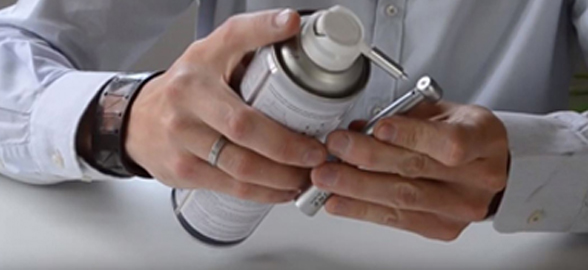How many types of dental burs exist? This is a question with a difficult answer since the catalog consists of hundreds of varieties, shapes, and brands.
Often, due to a simple lack of knowledge, both for the more advanced dental professional and for the dental student, some models that could facilitate the work in the dental clinic and in the laboratory are excluded.
From Dentaltix we understand how confusing it can be to buy online and have sorted out our category of dental burs to help you choose the one that best suits your needs without getting lost among all the questions..
In the 80s, it was decided, by the main international dental institutions, to unify dental burs under a common nomenclature and a universal classification, so they are included in the ADA specifications nº.23 and ISO standards.
In this image you can see a dental drill with its ISO code:

The following are the different classifications according to:
- The handpiece with which they are compatible (turbine, contra-angle, handpiece...)
- The material of the head (diamond or tungsten carbide)
- The shape of the head
- The roughness or grain size of the head
- The diameter of the head at its widest point.
Dental Burs according to Rotatory Instrument
The first and simplest classification is according to the type of rotatory instrument with which the dental bur will be used.
Dental Burs for TURBINE (High Rotation) or FG (Friction Grip):
These are the smallest ones, designed to be used with high-speed dental turbines. They have a shank diameter of 1.6mm and a free end. The shank length is defined by these ISO standards, always starting with 3XX (the final length may vary depending on the type and effective cutting shape).
On our website, we have a wide selection of turbine burrs both from diamond as also tungsten.

Dental Burs for CONTRA ÁNGULO (CA) or RA (Right Angle):
Of intermediate size for use with low/medium-speed dental contra-angles. They have a shank diameter of 2.35mm and a notch at the end of the shank that secures them to the instrument head and distinguishes them easily from the rest.
The shank length is defined by these ISO standards, always starting with 2XX (the final length may vary depending on the type and effective cutting shape). We also offer burs for contra-angles in both diamond and tungsten options.

Dental Burs for PIEZA DE MANO or HP (Hand Piece):
These are the larger-sized burs for use with handpieces in both clinical and laboratory settings, with a shank diameter of 2.35mm.
The shank length is defined by these ISO standards, always starting with 1XX (the final length may vary depending on the type and effective cutting shape). Additionally, we have a wide selection of laboratory burs.

Dental burs by type of material
.Tungsten Carbide Dental Burs (ISO 500):
Replacing the old all-steel burs, these are composed of this alloy in their active working part, which improves and reinforces their physical properties.
These burs are often used, for example, for skeletal and acrylic partial dentures due to their resistance.
Tungsten Carbide burs, according to ISO standards, are distinguished by the ISO 500 numbering.
Diamond Dental Burs:
This variant provides high-quality and precise burs thanks to the incorporation of multiple layers of carbon powder (diamond) in their working part through electroplating techniques. They are thicker than carbide burs.
Diamond dental burs, according to ISO standards, are distinguished by the ISO 806 numbering.
Dental Burs by Shape
Undoubtedly, this is their most defining and singular classification for each type of dental bur. Initially, they were simply named after their silhouette, such as the well-known "lance", "rugby ball", or "inverted cone" among others that we have tried to maintain.
Most commonly used dental bur shapes:
- Ball Bur: perfect for caries removal, cavity openings in operative dentistry, and creating orientation grooves in prosthetics.
- Cylindrical Bur, right-angle head: ideal for providing flat surfaces.
- Cylindrical Bur, curved head: indicated for creating occlusal orientation grooves.
- Round-tipped Conical Bur: suitable for inlays, orientation grooves, and bevels in pre-treatments for prosthetics.
- Conical Bur, right-angle head: perfect for creating steps and defining the terminal line of prosthetic preparations.
- Inverted Cone Bur: ideal for preparing retentive cavities.
- Flame Bur: indicated for lingual wear of incisors and canines.
- Wheel Bur: designed for obtaining mechanical retentions and extensive and heavy wear.
- Torpedo Bur: intended for creating terminal lines in fixed prosthetics.
Following the ISO standardization norm, among the majority of brands, we find each shape numbered with these numbers:
Main Diamond Dental Burs by Shape:

Main Tungsten Dental Burs by Shape:

Dental Burs by Granulometry
A single dental bur, with the same shape, can have different grain sizes depending on the treatment needs. They can be distinguished, in addition to the ISO numbering, by the specific coloration found on the color ring of the bur's neck.
In this way, from coarsest to finest grain, we find:


Dental Burs by Maximum Diameter of the Active Part:
This classification specifies the size of the tip or active part of the bur, so that within the same shape model, we can find different sizes.
Taking the ball bur (ISO 001 shape) as an example, we can find sizes ranging from ISO 009, the smallest, ideal for detailed work such as cleaning incipient caries points, to enormous diameters for use in prosthetics or surgery.

After reviewing this standardized normative; continuing with the example of the typical ball bur, whose ideal complete name, depending on each brand, should really be 806.314.001.524.016.

After seeing such an exhaustive guide, at Dentaltix we hope it will be of great help to you and make it easier for you to purchase dental burs.
Don't forget to follow us on social media, where you'll stay updated on all the latest news from the dental sector, we're waiting for you!







